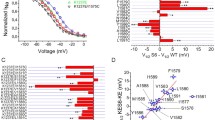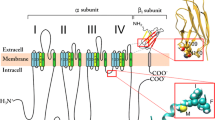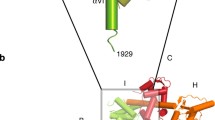Abstract
Failure of inactivation is the typical response of voltage-gated Na+ channels to the cytosolic presence of proteolytic enzymes, protein reagents such as N-bromoacetamide (NBA) or iodate, and antibodies directed against the linker between domains III and IV of the α-subunit. The present patch clamp experiments with cardiac Na+ channels aimed to test the hypothesis that these interventions may provoke the occurrence of non-inactivating Na+ channels with distinct kinetic properties. A site-directed polyclonal antibody (anti-SLP2, target sequence 1481–1496 of the cardiac Na+ channel α-subunit) eliminated fast Na+ inactivation to induce burst activity which was accompanied by the occurrence of two open states. A deactivation process terminated channel activity during membrane depolarization proceeding with time constants of close to 40 ms (at –40 mV). NBA-modified and iodate-modified Na+ channels were kinetically indistinguishable from the anti-SLP2-modified type since they likewise deactivate and, thus, attain an only moderate Po of close to 20%. This is fundamentally different from the behaviour of enzymatically-modified Na+ channels: after cytosolic proteolysis with α-chymotrypsin, trypsin or pronase, mean Po during membrane depolarization amounted to approximately 40% because deactivation operated extremely slowly and less efficiently (time constants 100–200 ms at –40 mV, as a minimum) or was virtually non-operating. In-vitro cleavage of the synthetic linker sequence 1481–1496 confirmed that this part of the α-subunit provides a substrate for these peptidases or reactants for NBA but cannot be chemically modified by iodate. This iodate resistance indicates that iodate-modified Na+ channels are based on a structural alteration of still another region which is also involved in Na+ inactivation, besides the linker between domains III and IV of the α-subunit. Endogenous peptidases such as calpain did not affect Na+ inactivation. This stresses the stochastic nature of a kinetic peculiarity of cardiac Na+ channels, mode-switching to a non-inactivating mode.
Similar content being viewed by others
Author information
Authors and Affiliations
Additional information
Received: 25 May 1996 / Accepted: 12 September 1996
Rights and permissions
About this article
Cite this article
Benz, I., Beck, W., Kraas, W. et al. Two types of modified cardiac Na+ channels after cytosolic interventions at the α-subunit capable of removing Na+ inactivation. Eur Biophys J 25, 189–200 (1997). https://doi.org/10.1007/s002490050031
Issue Date:
DOI: https://doi.org/10.1007/s002490050031




